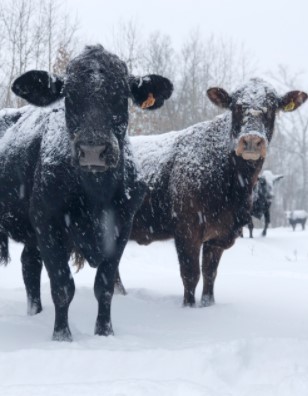By Mary Hightower
Fast facts
- Poultry growers keeping an eye on roofs bearing snow loads
- Ranchers outside ensuring water for cattle
Single-digit wind chills, freezing water in pipes and troughs and high snow loads on roofs are causing concerns for poultry and cattle operations, specialists from the University of Arkansas System Division of Agriculture said Monday.
Low temperatures reported Monday morning to the National Weather Service included minus 5 at Compton, zero at Lead Hill and 2 degrees at Gilbert. At noon Monday, the North Little Rock airport had 10.9 inches of snow, while Greers Ferry, Perryville and Vilonia all reported 11 inches of snow, according to the National Weather Service.

SNOW — Cattle in the snow at a Garland County farm. Taken Feb. 15, 2021.
For poultry growers, “the biggest problems are having water pipes freezing and watering equipment not working,” said Dustan Clark, extension poultry specialist for the Division of Agriculture. Clark said many growers are putting space heaters and heat lamps in control rooms to keep pipes from freezing solid and to allow electronic control equipment to keep operating.
“Some are getting very little sleep — setting alarms and some are staying up all night — to check waterlines and birds,” he said.
“Poultry growers that don’t have the best insulation; it’s going to be harder to keep those houses warm.” “Roof collapse – that is a worry,” Clark said. “Depends on how much snow you’ve got. Most can handle it, but when we have 8 inches of snow in this last round, and if we get much more; maybe 2-6 inches, that could be rough on some of those poultry houses.”
Keeping cattle fed, watered
“Cows in good body condition and have a good winter coat are fairly tolerant of cold weather,” said Shane Gadberry, professor-ruminant nutrition and extension specialist. “Arkansas cattle are at a disadvantage because they haven't had time to adapt to extremely cold temperatures.
Gadberry said “thin cows, cows with short hair, lactating cows, and Brahman-influenced cattle breeds will have a little tougher time meeting the increased energy needs when it is cold and wet outside.”
There are certainly no snow days for ranchers, who have to be outside, no matter the weather.
“Cows will eat more when they are really cold, so it is important to keep plenty of good quality hay in front of cattle at all times and supplement hay that is moderate- to low-quality with grain or grain byproduct-type feeds,” Gadberry said. “Ranchers may want to avoid using range meals at this time because the salt will make cows want to drink and the bitter cold is making a lot of water sources frozen over and less accessible.
“It is important to break ice and make water accessible to maintain normal water consumption,” he said. “Hopefully this event won't last more than a week.” However, when things start to thaw out, there are still issues ranchers need to worry about.
“When the temperature gets back to normal and the ground thaws, feeding areas may need to be relocated or ranchers may want to start unrolling hay to keep feeding sites distributed over larger areas to avoid creating deep mud tracks,” Gadberry said. “Deep mud makes it difficult for cattle to get to hay and eat as much as they could otherwise.”
Source : uaex.edu